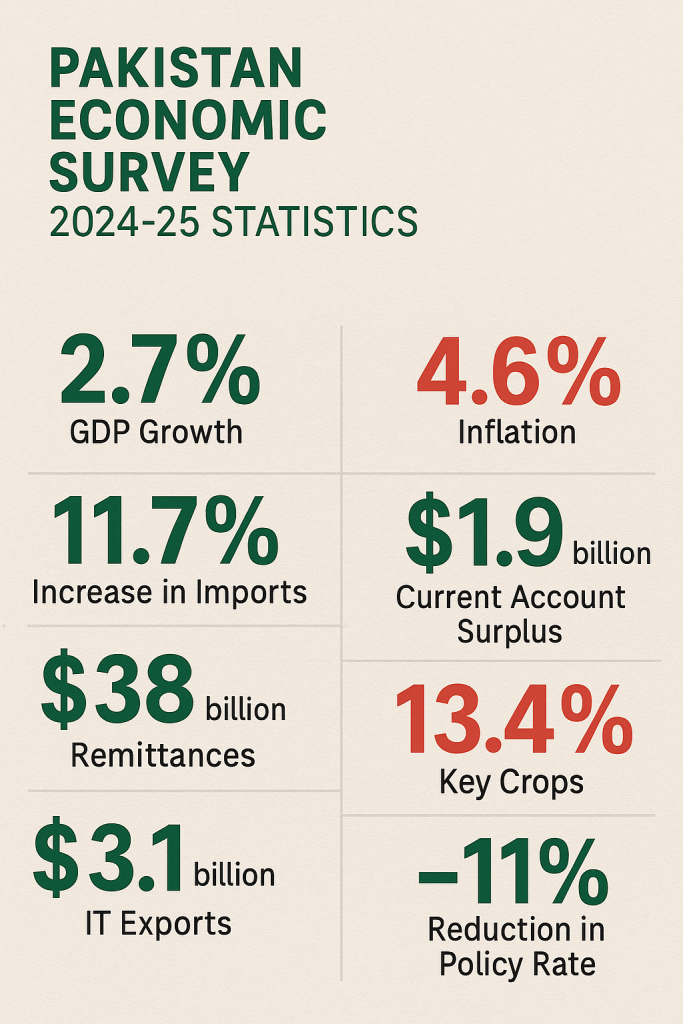In a hopeful turn for Pakistan’s economy, Federal Finance Minister Muhammad Aurangzeb revealed on Monday that the country’s GDP growth rate in Pakistan reached 2.7% during the outgoing fiscal year 2024-25, while inflation dropped to a significantly low 4.6%.
Presenting the Pakistan Economic Survey 2024-25, the minister painted a cautiously optimistic picture of the nation’s economic progress, just a day before the federal budget is set to be announced.
Aurangzeb pointed out that two years ago, in 2023, Pakistan’s GDP growth was the negative and inflation had soared to an alarming 29%. “Since then, we’ve made some bold policy decisions — and today, we’re witnessing the positive results,” he stated during his address.
Read More: Budget 2025-26: Massive increase in salaries on cards
One of the biggest highlights was the sharp cut in the policy rate, which was slashed from 22% to 11%, offering much-needed relief to businesses and investors. This, the minister said, was made possible due to major fiscal discipline and ongoing structural economic reforms.
Furthermore, the survey revealed promising signs of fiscal stability. Exports increased by 7%, with the IT industry serving as a source of hope. Pakistan’s freelancers netted $400 million, while the IT exports of the country amounted to $3.1 billion. Remittances — the lifeline of foreign exchange — picked up to $38 billion, portraying a rise of $10 billion in merely two years.
Also Read: Why is the govt pushing digital payments for fuel purchases?
Revenue collection also witnessed a healthy 26% jump, and the number of individual tax filers has doubled. “We are changing the economic DNA of Pakistan,” Aurangzeb emphasized, as he praised the reforms introduced under Dr. Shamshad Akhtar’s guidance and efforts in tax and energy sectors.

The minister shared that 24 state-owned enterprises (SOEs) are being moved toward privatization, and a new defined contribution pension system is being rolled out as part of broader financial reforms. “We’re committed to plugging leakages, right-sizing departments, and merging overlapping ministries. The aim is efficient governance with reduced public expenditure,” he added.
Know More: Budget 2025-26: No new tax on solar panels, confirms FBR
Despite these achievements, the agricultural sector faced serious setbacks. Key crop production declined sharply — cotton saw a 30% drop, wheat fell by 8.9%, and maize dipped by 15.4%. However, some positive growth was recorded in the production of potatoes and onions, which rose by 11.5% and 15.9% respectively.
The finance minister also emphasized growth in the machinery, transport, and construction sectors. Industrial growth as a whole was measured at 6%, while the services sector grew more than 2%. Agriculture, however, grew almost not at all, posting only a 0.6% increase — an obvious area of focus for future policy.
In his valedictory, Aurangzeb was optimistic that GDP growth rate in Pakistan will remain on an upward path. “We’re not running after foreign loans anymore. If we borrow now, it will be on our terms,” he claimed, emphasizing the government’s aim to focus on sustainable growth and long-term stability through structural economic reforms.



